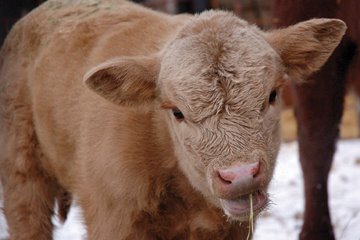by Karen Emilson
Cattle producers in the flooded Interlake and Westlake Regions will soon have access to a Targeted Advance Payment (TAP) on their 2008 AgriStability payment. The TAP is meant to assist producers who need to purchase feed for their animals this winter.
This recent announcement made by the provincial government has Directors with the MCPA concerned that these payments aren’t the bulls eye producers need right now. In fact, they might be missing the target altogether.
District 10 Director, Joe Bouchard, lives near Fisher Branch. Many of the producers he represents around the MCPA board table found themselves short of feed this fall.
Bouchard attended numerous meetings with government and has spoken publicly about the issue. His main concern is that there are producers who will receive a payment and then be required to pay it back.
“I appreciate the gesture on the part of the Minister to get money into producer’s hands, but the problem is that the program still isn’t fixed,” he said. “We have told the bureaucrats time and again that AgriStability doesn’t work for cattle producers.”
He said that producers are beyond frustrated that the program doesn’t work and the politicians can’t figure out why. He says that the people who designed the program don’t see a problem with it, but that just because it works on paper, doesn’t mean it works in the real world.
“The tragedy is that there are people who are getting money who don’t need it and people in dire need who aren’t getting anything. The cattle industry is being obliterated, while the grain producers have production insurance and Agristability which does work for them, and as livestock producers we don’t have either. ”
Bouchard said that the government needs to work with industry to get the problems fixed.
“If the bureaucrats got paid on a commission basis by how well the program worked for cattle producers, they would be starving to death.”
Earlier this fall, the MCPA had producers in the flooded areas volunteer to fill out the AgriStability Interim Advance form and then monitored whether or not those producers were eligible for a payment. One out of three people qualified.
Based on those results, Bouchard is asking producers to be cautious about accepting the Targeted Advance.
“They need to know that this is AgriStability money that will have to be paid back if they are ineligible for a payout in 2008,” he warned.
At press time, Bouchard wasn’t exactly sure how the payments would be calculated but says the amounts will likely be based on individual production units. The estimated average advance will be in the range of $8,400 however, producers who are not enrolled in AgriStability for 2008 are ineligible.
“The government has been telling us that the new Growing Forward programs are the only game in town but cattlemen are reluctant to sign up because it hasn’t worked for them in the past,” he said. “The government has to take the lead and get this program fixed and then they would see more cattle producers enroll.”
Art Jonasson is the District 11 Director living at Vogar. He is concerned that the decisions producers make between now and the end of the year could negatively affect their future margins.
“And a lot of those are good, solid management decisions they will be making,” he said, explaining that producers he has talked to who usually cull around 10 percent of their cows may cull heavier at 15 to 20 percent, rather than purchasing expensive feed. Few producers (if any) fertilized this fall. How a drop in expenses and production units will affect each individual program year margin varies.
“Every situation is different and so it is every producer’s decision whether or not they take the Targeted Advance,” he said. “Worse case scenario is that it is an interest free loan and I would suggest guys should view it that way.”
Jonasson explained that in the past, producers who were in the former CAIS program and stayed with it, did not have to directly pay back overpayments. Those amounts were simply subtracted from any future payments. AgriStability is set up the same way.
To qualify, producers must have 50 percent or more of their farm income derived from ruminant sales. They also must live in the R.M.s of St. Laurent, Coldwell, Siglunes, Grahamdale, Fisher, Bifrost, Eriksdale, Armstrong, Gimli, Alonsa, Mossey River, Ethelbert, Mountain South or Lawrence, or in areas of Northern Affairs or First Nations next to these municipalities.
The government press release made no mention of producers living in the southwest where some are also suffering severe feed shortages but due to drought. Jonasson said both the north and south were included in the discussions with government and they will be looking into why the southwest was left out and lobbying for their inclusion.
Welcome to the Online Edition of Cattle Country!
Updated with every new issue
Past issues will be available in the archive. If you are interested in reading Late Breaking News between paper deadlines, scroll down to the bottom of the page. The most recent information will be posted first.
Past issues will be available in the archive. If you are interested in reading Late Breaking News between paper deadlines, scroll down to the bottom of the page. The most recent information will be posted first.

Thursday, December 4, 2008
Subscribe to:
Post Comments (Atom)

No comments:
Post a Comment